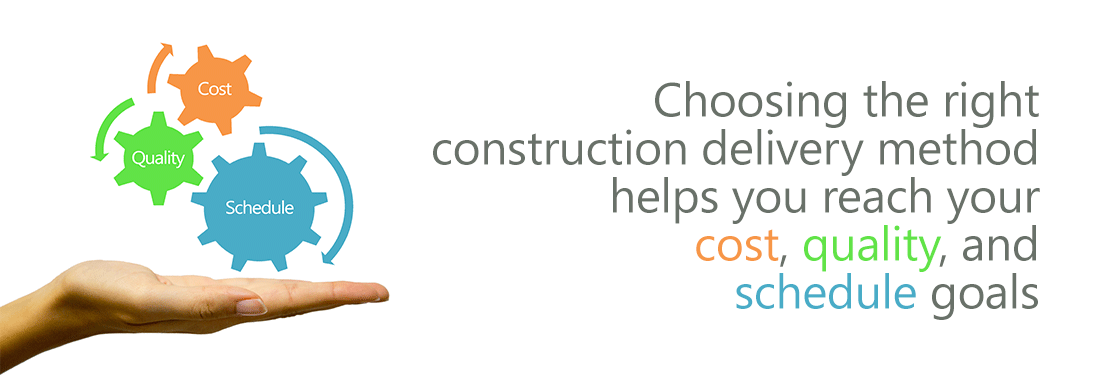It’s time. You’re ready to plan your new renovation, addition, or construction project. If you’ve come to this point, you know why you’re building, but the how is the kicker: How do I begin? How do I choose the best delivery method for my project — and my peace of mind? How do I evaluate my options?
Delivering your construction project
Choosing the right delivery method for your construction project reduces risk and improves the likelihood of attaining your cost, quality, and schedule goals. It gives you additional control over certain elements of the project and flexibility for potential change along the way.
There are many construction delivery methods — and variations on those methods — to choose from. Each has its use depending on the project’s needs. Below I offer you an overview of four common methods, but I recommend discussing your specific situation with an owner’s representative before moving forward to ensure you make the right choice for your construction project.

Method 1: General contractor (GC)
The GC method follows the traditional design, then bid, then build process. Owners are typically comfortable with this familiar method because it is a simple process to manage, they have significant control over the project’s design, and there is an inherent “checks and balances” relationship between each party involved.
Owners start by hiring an architect to design the project in its entirety, and when the design is complete, they bid the package out to a small group of contractors. This linear process takes more time than some of the other methods, and it can lead to unexpected costs and quite often an adversarial relationship between the parties as change orders and schedule problems arise.
Method 2: Construction Manager as constructor (CMc) or agency (CMa)
When owners hire a construction manager (CM) for their projects, they moderate some of the shortcomings of the traditional GC method. This method begins with owners hiring not only an architect but also a CM that helps the architect design with an eye toward budgeting, scheduling, and constructability. Because of this team approach, the conflict between parties is lessened and fewer change orders typically arise. However, if not managed correctly, the CM method may cost considerably more than other methods.
CMs come in two flavors: construction manager as a constructor (CMc) or as an agency (CMa). The difference lies in the allocation of risk. In the CMc method, the CM is contractually responsible for over-budget costs and schedule overruns, but the CMa model has the owner — and not the CM — assume the risk of delivery. Deciding which variation (CM “at risk” or “not at risk”) can be difficult; owners need to carefully weigh the level of risk they’re willing and able to assume.
Method 3: Design/build (DB)
If cost and scheduling are the driving issues for a project with a fixed budget and drop-dead completion date, design/build (DB) is a method to consider. DB is time efficient and simple for the owner, who from the start hires one entity to handle both the design and construction. The DB team works together on all the drawings, specifications, and construction, so there are usually few inter-party conflicts and change orders involved.
Unfortunately, there can be some significant drawbacks to the DB method. Having the design be controlled by a predetermined budget — coupled with a speed-over-accuracy mentality and limited checks and balances — may mean quality will suffer. Moreover, many DB firms don’t have the resources or knowledge to handle highly specialized or technical projects, limiting their usefulness for jobs that require unique building designs or industry-specific specifications.
Variations
Most methods can be augmented to make up for their limitations, such as introducing a customized phased construction schedule to help reduce the time to delivery and increase efficiencies. They may also be adjusted to take into account an organization’s priorities and risk tolerance, which creates variations like the final method I’ll discuss, Design Prime.
Method 4: Design prime
The Design Prime method is a variation of the traditional GC method, but with some major changes in the parties involved. When employing the Design Prime method, the owner hires an architect/engineer to complete the design process and then engages the trade contractors directly for their insights into the planning and constructing process. Used for simple projects with minimal coordination (think roofing or paving), Design Prime helps deliver efficient, effective construction projects.
Making an informed decision
We highlight only four of the numerous delivery methods, and you can tell just from their brief descriptions that deciding the best one for your project is a complex and nuanced process. To keep your investment safe and your project running smoothly, it is imperative that you carefully evaluate each option in light of your project’s needs and priorities before moving forward.
For help thinking through these options, contact us today. Our experts have an average of 20+ years in the construction industry and can offer you valuable insights during every step of the construction process, from concept to completion, through a comprehensive array of project management services >>




